1976 CHEVROLET MONTE CARLO steering wheel
[x] Cancel search: steering wheelPage 14 of 102
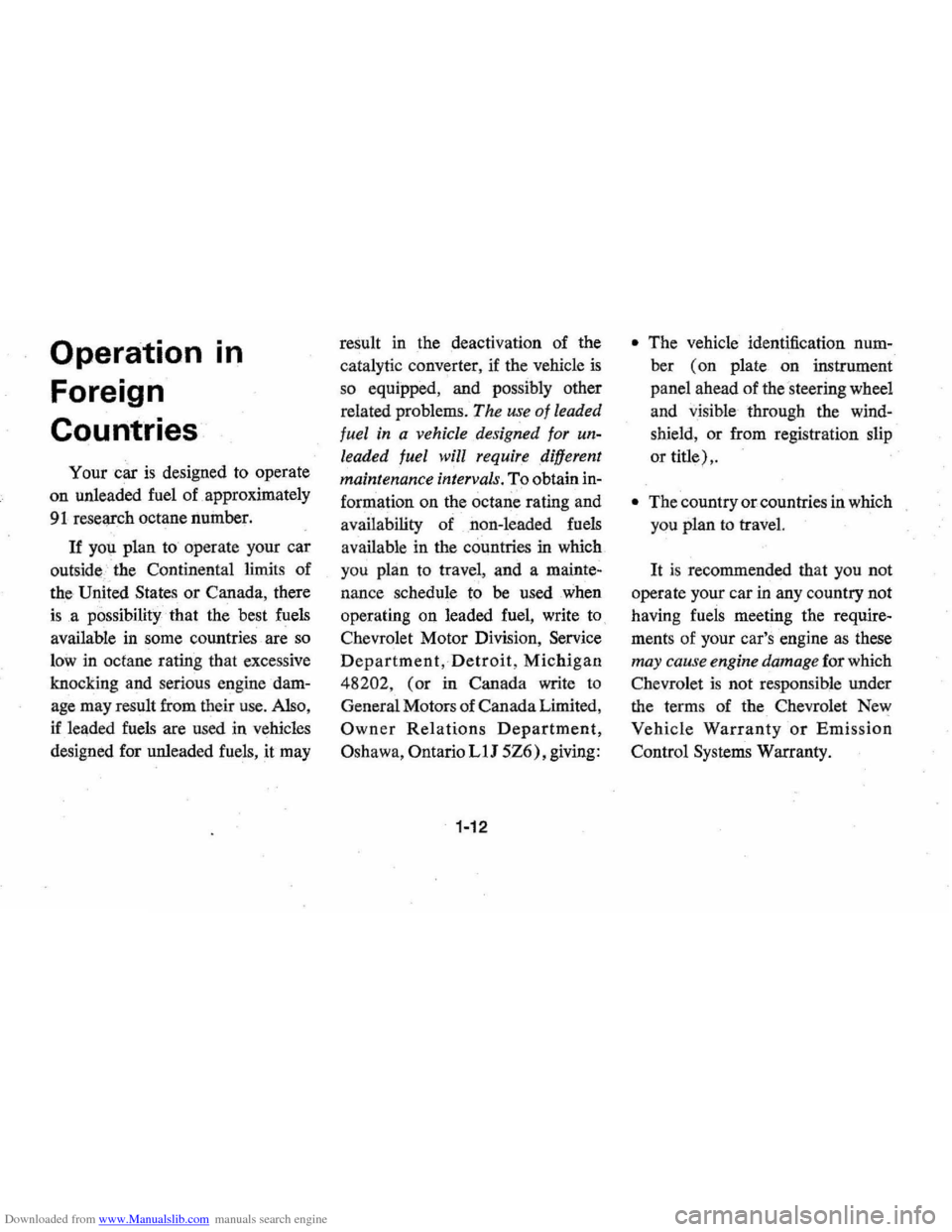
Downloaded from www.Manualslib.com manuals search engine Operation Foreign
Countries
.
In
Your car is designed to operate
on unleaded fuel
of approximately
91 reseljl'ch octane number.
If you plan to' operate your car
outs ide . the Continent al limits of
the
U niled States or Canada, there
is .a possibility that the best fuels
available
in some countries are so
low in oclane rating that excessive
knocking and serious engine dam
age may result from their
use. Also,
if leaded fuels are used in vehicles
designed for unleaded fuels, it may result
in the
deactivati on of the
catalytic converter, if the vehicle
is
so equipped , and possibly other
related problems.
The use of leaded
fuel
in a vehicle designed for un
leaded fuel
will require different
maintenance intervals.
To obtain in
formation on the
octan~ rating and
availability of non-leaded fuels
available in the countries in which
you plan to travel , and a mainte
nan ce schedule to
be used when
operating on leaded fuel, write to
Chevrolet Motor Division, Service
Department,Detroit, Michigan
48202, (or in Canada write to
General Motors of Canada Limited,
Owner Relations Department,
Oshawa, Ontario LlJ 5Z6), giving:
1-12
• The vehicle identification num
ber (on plate on instrument
panel ahead of the steering wheel
and vis ible through the wind
shield , or from registration slip
or title)
,.
• The country or countries in which
you plan
to travel.
It is recommended that you not
operate your car in any country not
having fuels meeting the require
ments of your car's engine
as these
may cause engine damage for which
Ch evr olet is not respon sible under
the term s of the Chevrolet New
Vehicle Warranty or Emission
Control Systems Warranty .
Page 16 of 102

Downloaded from www.Manualslib.com manuals search engine STEERING COLUMN CdNTROLS
Anti-. Steering
Column Lock
The
anti-th eft lock, located on
the right side of the stee ring col
umn, has five positions:
• Accessory -Permits operation
of electr i
cal accessories when
engine is not running. To
en
gage, push key in and turn
toward you (counterclockwise).
• Lock-Normal parking position.
L
ock s igniti on and provides added
theft protection
by prevent
ing normal operation of steering
wheel and shift controls . to
"lock"
po sition and removed until trans
mission is placed in "park".
• Off
-Permits turning engine off
without locking steering wheel and
shift controls.
• Run (ON) -Normal operating
position
. .
•
Start -Permits engagement of
starter.
NOTE: The ontl-theft otee,lng column lock is not 8:,lubltItUte tor· the parking brake. Always let the , parking brak, when leaving the car una"ended.
If difficulty is experienced in
turning the ignition key and lock
knob to unlock the ignition,
at
tempt to turn the steering wheel lIS
hard as possible in the direction the
wheels are turned.
At the same
time turn the ignition-lock knob in
2-2
a clockwise direction wi(h as.much
effort
as you can apply with your
own hand. Do not attempt to
use
a tool of any kind to apply addi
tional force on the lock knob, as
this could break the knob.
Parking
When leaving your car unattended:
• Set parking brake.
• Place automatic transmission se
lector in Park.
•
Turnkey to LOCK position.
• Remove key (the buzzer will re
mind you).
• Lock all doors.
IMPORTANT : Do not park your car over combustible materials, such 8S grlss or leaves, which can come Inlo contact with the hot exhaust system and cause such materials to Ignite under certain wind and weather condition ••
NOTICE:
Do not I.ave your car unattended with ~ engine running. If the engine
should overheat While your car is -unat·
tended , the temperature warning light or gauge would go unheed9d, which could result in extensive damage to your car.
Page 19 of 102

Downloaded from www.Manualslib.com manuals search engine Turn Signals and Lane
Change Feature
The tum signal lever is located on
·the l eft side of the steering column
immediately under the steering
wheel. The lever is moved upward
to signal a right tum and down·
ward to signal a left tum. Lamps
on the front and rear of the car
transmit this signal to other motor
ists and pedestrians. The ignition
P PARK R REVERSE N - NEUTRAL
D DRIVE
TURBO HYDRA·MATIC
Use only when vehicle is stopped . For backing vehicle from stop. For standing (Brakes Applied), For forward driving.
Depress accelerator to floor for extra acceleration below 65 mph; depress accelerator half-way at speeds below 30 mph. For driving in hea.vy traffic or on hilly terrain. Shift Into l2 at any veh icle
speed. The transmiss ion will shift into second gear and remain in sec ond until the vehicle speed or throttle are reduced to obtain first gear operation in the same -manner 85 in 0 r a n ge. ~ range posit ion prevents the
transmiss ion from shifti ns to 3rd gear.
For hard pulling through sand, snow or mud, and for climbing or descending steep /lrades. Shift in~o LI at any vehicle speed. Depending upon the axle ratio of the v. ehicte the transmission will shift to sec~nd gear at any
speed above approximately 40 mph and will shift to 1st \gear 2IS speed is reduced below 40. II range position pr~vents the transm iss ion from shifting out of first. gear.
2-5
switch must be in the "ON" posi
tion in order for the turn signals to
be operational. This feature pre
vents battery drain if the lever is left
in an
"ON" position when your car
is not in use.
In a normal turning situation
such
as turning a comer , the turn
signal
is canceled automatically
after the
tum is completed. How
ever, in some driving maneuvers
Page 20 of 102
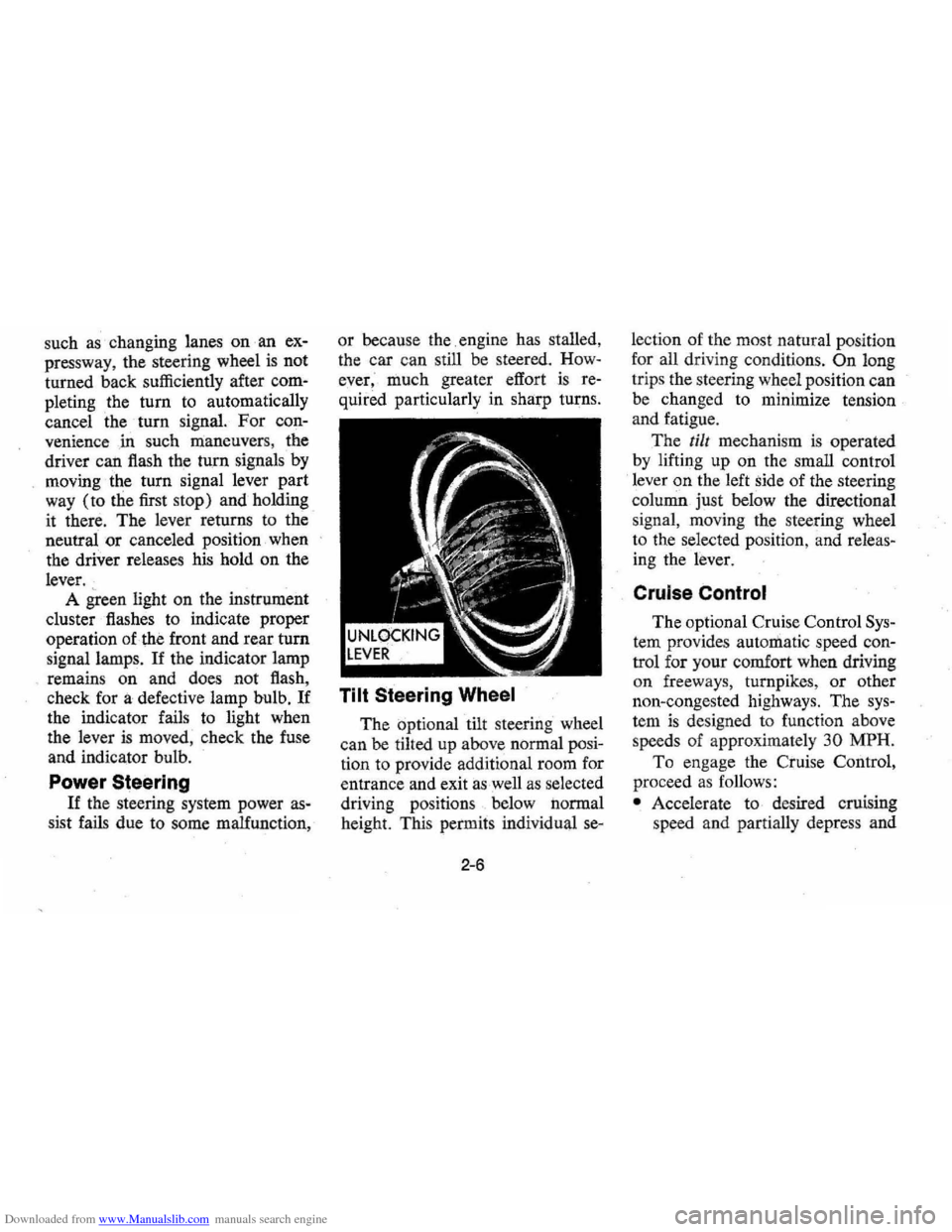
Downloaded from www.Manualslib.com manuals search engine such as changing lanes on an ex
pressway , the steering wheel
is not
turned back sufficiently after com
pleting the turn to automatically
cancel the turn signal.
For con
venience
,in such maneuvers, the
driver can flash the turn signals by
moving the turn signal lever part
way (to tlie first stop) and holding
it there. The lever returns to the
neutral
or canceled position when
the driver releases his hold on the
lever. A
green light on the instrument
cluster flashes to indicate proper
operation of the front and rear turn
signal lamps.
If the indicator lamp
. remains on and does not flash,
check for a defective lamp bulb.
If
the indicator fails to light when
the lever
is moved , check the fuse
and indicator bulb.
Power Steering
If the steering system power as
sist fails due to some malfunction, or
because the. engine has stalled,
the car can still be steered. How
ever; much greater effort is re
quired particularly in sharp turns.
Tilt Steering Wheel
The optional tilt steering wheel
can be tilted up above normal posi
tion to provide additional room for
entrance and exit
as well as selected
driving positions below normal
height. This permits individual
se-
2-6
lection of the most natural position
for all driving conditions.
On long
trips the steering wheel position can
be changed to minimize tension
and fatigue.
The
till mechanism is operated
by lifting up on the small control
lever
on the left side of the steering
column just below the directional
s ignal , moving the steering wheel
to the selected position, and releas
ing the lever.
Cruise Control
The optional Cruise Control Sys
tem provides automatic speed con
trol for your comfort when driving
on freew a
ys, turnpikes, or other
non-congested highways. The
sys
tem is designed to function above
speeds of approximately
30 MPH.
To enga ge the Cr:uise Control,
proceed
as follows:
• Accelerate to desired cruising
speed and partially depress and
Page 21 of 102
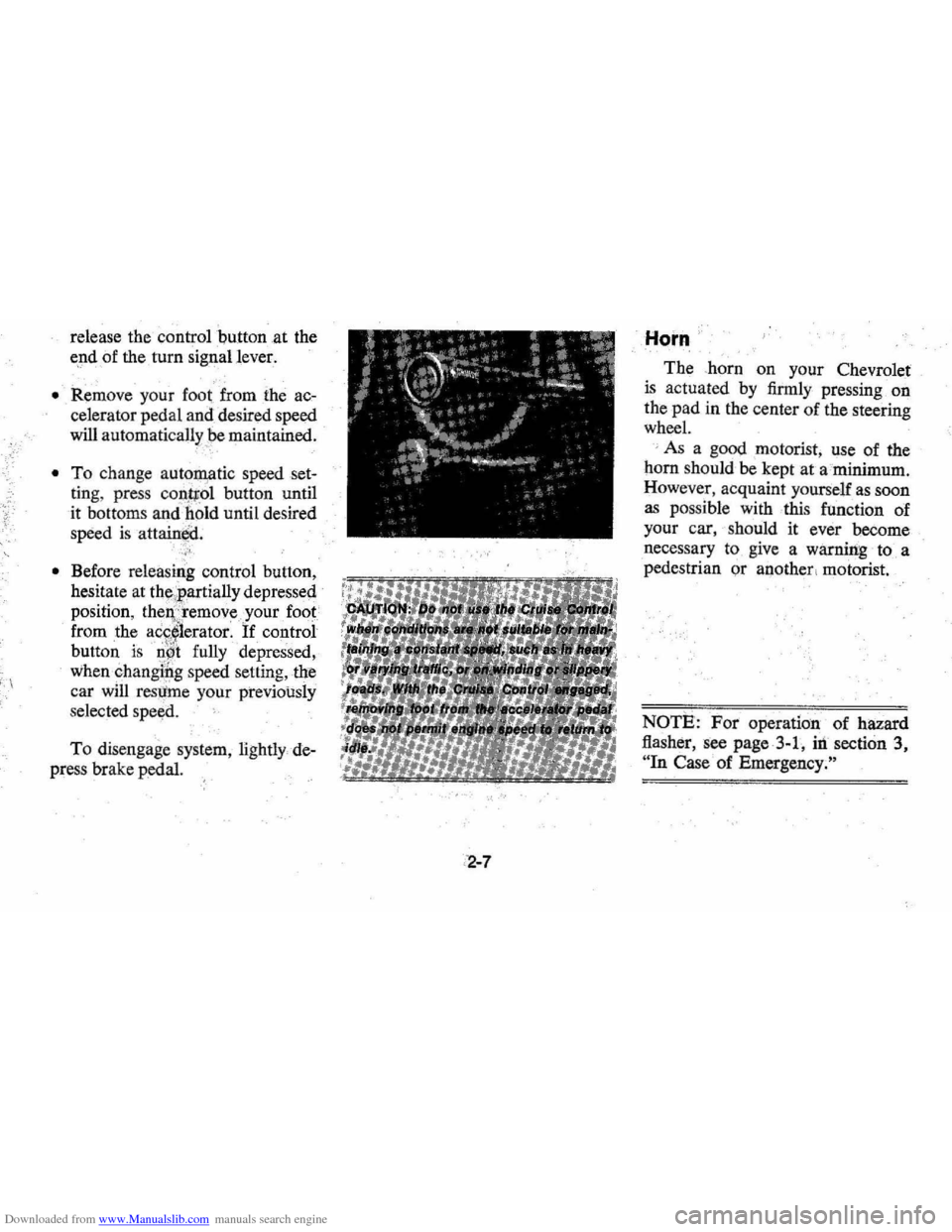
Downloaded from www.Manualslib.com manuals search engine release the controlputton at the
e,ndof the turn signallever.
'. ~
• Remove your fool from the ac
celerator pedal and desired speed
will automatically
be maintained . /.
• To change autoIllfltic speed set
ting , press
con.tllol button until
it bottom s and
hold until desired
speed is attain!id.
•
Before releasi~g control button,
hesitate at
th!'!igartially depresse\l
position, th~I},:,remove your foot
from the
ac~,~lerator. If control
button
is IIW t fully depressed,
whenchangi#g speed setting, the
car
will resume your previously
selected
spe~d.
To disengage system, lightly de
press brake
p~al.
, ,.,
Horn
The .horn on your Chevrolet
is actuated by firmly pressing on
the pad in the center of the steering
wheel.
' As a good motorist, use of the
horn should
be kept at a minimum .
However , acquaint yourself
as soon
as possible with this function of
your car, should it ever become
necessary to give a warning to a
pedestrian or another , motorist.
NOTE: For operation of hazard
flasher, see page .3-1, iii section 3,
"In Case of Emergency."
Page 48 of 102

Downloaded from www.Manualslib.com manuals search engine l,nCase of Emergency '
Four Way Hazard
Warning Flasher
• Use the warningJlashe~ to warn
othe~ drivers allY time your ve
hicle becomes a traffic hazard,
day
ornight. ",
•
A void stopping on the roadway
if possible, .
.' Turn on the hazard warning
flasher
by pt\'shing in on the but,
ton located on the column just
below the steering
wheeL Flasher
can
be actuated with engine igni
tion either off
or on.
• Turn signals do not work with
hazard flashers operating.
• If the brake pedal is depfessed,
the lights will not flashbutre
main continuously lit
• To cancel the flasher, pull the
button out.
'':.',
Freeing Car From Sand; etc.
If it becomes 'neces sary to rock
the car to free it from sand, mud
or snow, move the selector lever
on automatic transmission models
from '~D" to "R" in a repeat pat
tern while simultaneously applying
moderate pressure to the accelera-
3-1
tor. Do not race engine. For best
possible traction, avoid spinning
wheels while
trying to free the car.
The use of AC Liquid Tire Chain
is recommended for temporary as
sistance when traction is lost on ice
or snow.
Towing
Proper lifting and towing equip
ment
is necessary to prevent dam
age to the vehicle during any
tow
ingoperation. State (Provincial in
Canada) and local
laws applicable
to vehicles in tow must be followed.
Detailed towing instructions are
available at your Chevrolet dealer.
Page 49 of 102
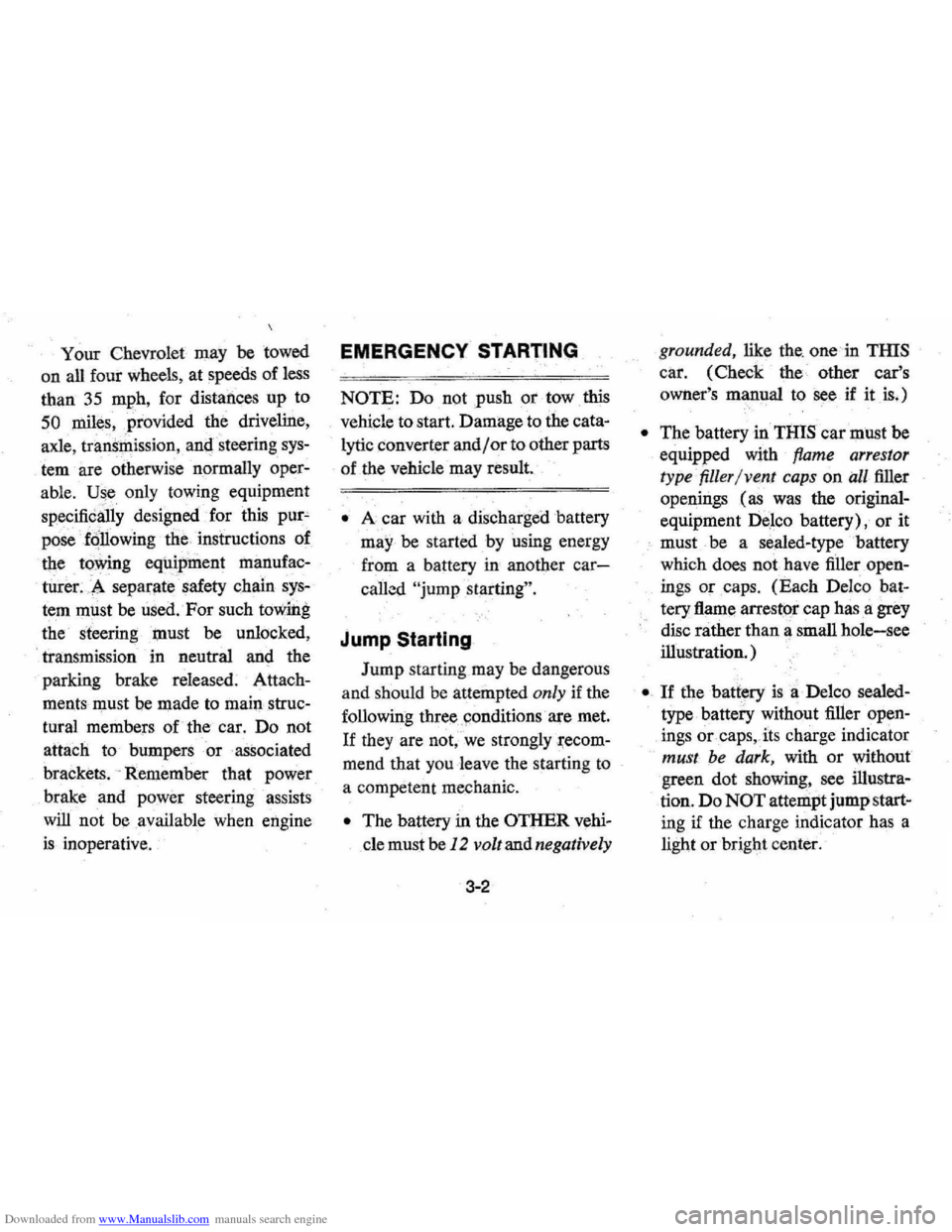
Downloaded from www.Manualslib.com manuals search engine Your Chevrolet may be towed
on all four wheels , at speeds of less
than
35 mph, for distances up to
50 miles, provided the driveline,
axle , tranSmission, and steering
sys
tem are otherwise normally oper
able.
Use only towing equipment
specifically designed for this
pur'
pose following the instructions of
the
towing equipment manufac
turer.A separllte safety chain sys
tem must be used. For such towing
the steeringi;Dust be unlocked,
' transmission in neutral
an~ the
parking brake released. Attach
ments must
oe made to mai!1 ,struc
tural members of the car. Do not
attach to bumpers or
,aSsociated
brackets. ' Remember that power
brake and power steering assists
will not be ,available when engine
is inoperative,
EMERGENCY STARTING
NOTE: Do not push or low this
vehicle to start. Damage to the cata
lytic converter and / or to other parts
of the vehicle may result.
• A car with a discharged 'battery
may be started by using energy
from a battery
in' another car
call<:!d "jump starting ".
Jump Starting
Jump starting may be dangerous
and should
be attempted only if the
followi!1g three , ,~onditions are met.
If they are not, we strongly,~ecom
mend that you leave the starting to
a competent mechanic.
• The battery in the OTHER vehi
cle must be
12 volt and negatively
3-2
grounded, like the, one in TillS
car. (Check the' other car's
owner's manual
to see if it is.)
• The battery in THIS car must be
equipped with
flame arrestor
type
filler / venl caps on all filler
openings (as
was the original
equipment
De ,lco battery), or it
, must be a sealed-type battery
which does not have
fi'tler open
ings or
caps, (Each Delco bat
tery flame arrestor cap has a grey
disc rather than a small hole-see
illustration. )
•. If thebatiery is a Delco sealed
type battery without filler open
ings or
caps"its charge indicator
must be dark, with or without
green dot showing, see illustra
tion. Do
NOT attempt jump start
ing
if the charge indicator has a
light or bright center.
Page 92 of 102
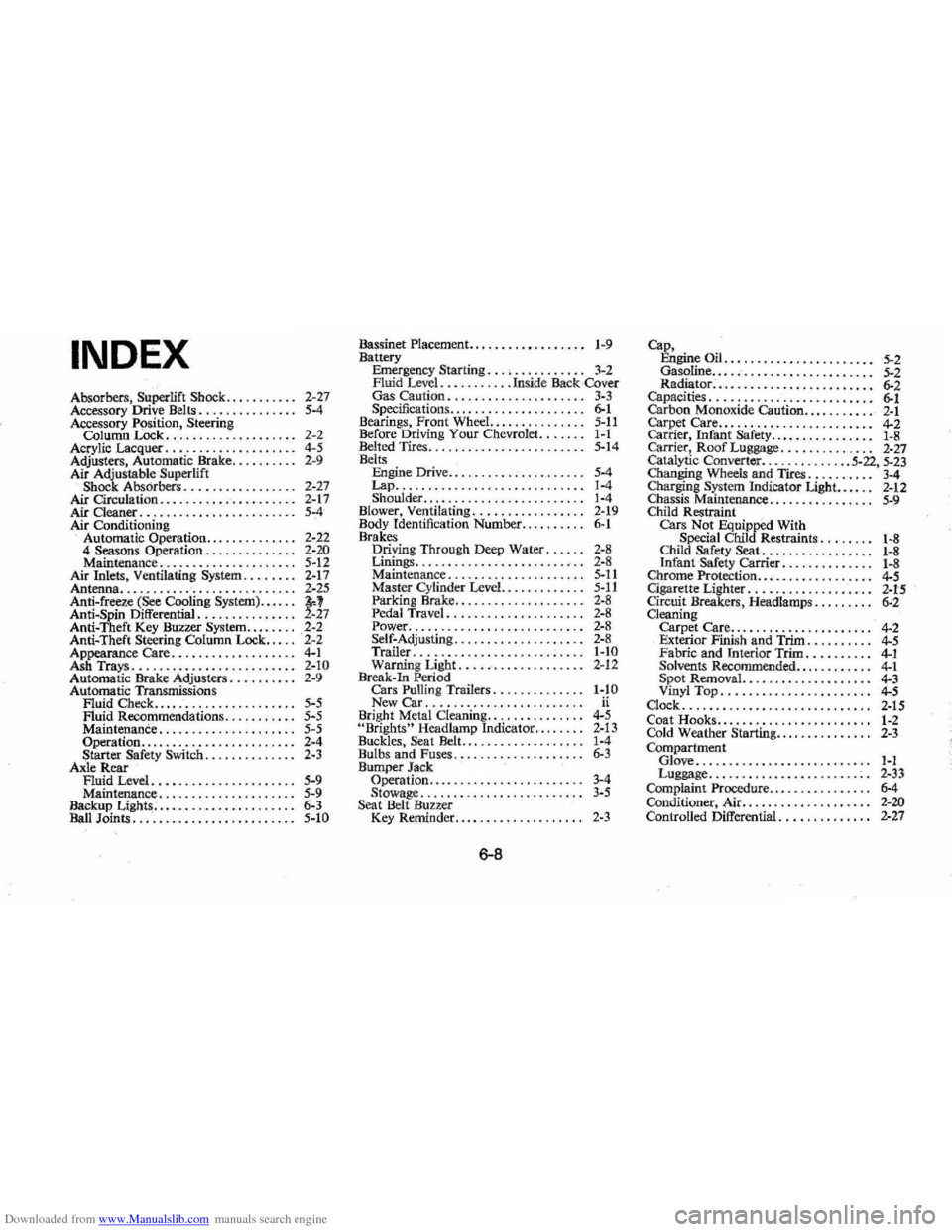
Downloaded from www.Manualslib.com manuals search engine INDEX
Absorbers, Superlift Shock. . . . . . . . . .. 2-27
Accessory Drive Belts. . . . . . . . . . . . . .. 5-4 Accessory P()sition, Steering Column Lock. . . . . . . . . . . . . . . . . . .. 2-2
Acrylic Lacquer. . . . . . . . . . . . . . . . . . .. 4-5 Adjusters, Automatic Brake. . . . . . . . .. 2-9 Air Adjustable Superlift Shock Absorbers. . . . . . . . . . . . . . . .. 2-27 Air Circulation .......... " ..••..... 2-17 Air Cleaner . . . . . . . . . . .. . . . . • • . . . . .. 5-4 Air Conditioning
Automatic Operation. .. . . . . . . . . . .. 2-22
4 Seasons Operation. . . . . . . . . . . . .. 2-20 Maintenance. . . . . . . . . . . . . . . . . . . .. 5-12 Air Inlets , Ventilating System ........ 2-17 Antenna •.......... -•....•• , . • . . . . .. 2-25 Anti-freeze (See Cooling System).... .. ~l Anti-Spin Differential. . . . . . . . . . . . . .. 2-27 Anti-Theft Key Buzzer System ........ 2-2 Anti-Theft Steering Column Lock. . . .. 2-2
Appearance Care. . . . . . . . . . . . . . . . . .. 4-1 Ash Trays. . . . . . .. .. . . .. . . . . . . . . ... 2-10 Automatic Brake Adjusters. . . . . . . . .. 2-9 Automatic Transmissions Fluid Check.. .. . . . . . . . . . . . . . . . . .. 5-5 Fluid Recommendations ... , . . . . . .. 5~5 Maintenance. . . . . . . . . . . . . . . . . . . .. 5-5 Operation ...... ,., ....... "., .... 2.4
Starter Safety Switch .. , ..•• ' .• ' . '. 2·3 Axle Rear Fluid Level ............... , . . . . .. 5-9 Maintenance .............•...... , 5·9 Backup Lights.... . . . . .. . . ... . . . . . .. 6-3 Ban Joints . . . . . . . . . . . . . . .. .. . .. . . .. 5·10
Bassinet Placement.. • . . . . . . • . . . . .. .. 1-9 Battery Emergency Starting, . , •...... , . . .. 3-2 Auid Level ........ , , .In side Back -Cover Gas Caution. .. .. . . .. . . . . . . .. . . .. 3-3 Specifications ....... , ............. 6-1 Bearings, Front Wheel. ......... , .... 5·11 Before Driving Your Chevr olet. ...... 1-1 Belted Tires .. , "., ............ , .... 5·14 Belts Engine Drive .... , . . . . . . . . . •.. . . . .. 5-4 Lap ............................. 1-4 Shoulder, ......... , ............ '. 1-4 Blower, Ventilating ................. 2-19 Body Identif ication Number .......... 6-1 Brakes D,riying Through Deep Water, . , , .. 2-8 Linings .. , ...................... , 2-8 Maintenance ..... ' . ... , . . . . . . . . . . 5-11 Master Cylind er Level ......••..... 5-11 Parking Brake.. . . . . . . . . . . .. . . . . .. 2-8 Pedal Travel ........... , . . . . . . . .. 2-8 Power, ...................• , ..... 2-8 Self-Adjusting ... , .......• " ...... 2-8 Trailer .................... ,..... I-to Warning Light. .... -.............. 2-1 2 Break-In Period Cars Pulling Trailers. . .. ...... .... 1-10 New Car ......... ,., ... ,........ ii Bright Metal Cleaning ....... '. ' . . . . .. 4-5 "Brights" Headlamp Indicator , ...... , 2-13
Buckles, Seat Belt., ........... ,. .. .. 1-4
Bulbs and Fuses .............. , . , . .. 6-3 Bumper Jack
Operation ........ , ...•••••..•.... 3-4 Stowage ............ , .••. , . . . . . .. 3-5 Seat Belt Buzzer Key Remin der ................ , . .. 2-3
6-8
Cap,
Engine Oil ...... , . . . . • . . . . . . • . . .. 5-2 Gasoline ............. , . . . . . . • . . .. 5-2
Ca~~~fti~~·:::::::::::::::::: :::::: ~: Carbon Monoxide Caution •.. , ..•.... 2-1 Carpet Care... . . . . .. . . . . . .. . . . . .. .. 4-2 Carrier, Infant Safety................ 1-8 Carrier, Roof Luggage ........ , . . . .. 2~27 Catalytic Converter ........... , .. 5-22, 5-23 Changin g Wheels and TlCes. . . . . . . . .. 3-4 Cha rging System Indicator Light...... 2-12
Chassis Maintenance. . . . . . . . . . . . . . .. 5-9 Child Restraint
Cars Not Equipped With
Special Child Restraints. , .. , ..• 1-8
Child Safety Seat. .. . .. . . . . . .. . . .. 1-8 Infant Safety carrier. .. . . . . . . . . . .. 1-8 Chrome Protection ....... , .......... 4-5 Cigarette Lighter. . . . . . . . . . . . . . . . .. . 2-15 Circuit Breakers, Headlamps. . . . . . . .. 6-2 Cleaning
Carpet Care.. . . . . . . . . . . . . . . . • . . .. 4~2 Exterior Finish and Trim. . . . . • . . .. 4-5 Fabric and Interio r Trim .......... 4-1 Solvents Recommended ........ , . .. 4-1 Spot Removal. ...... : . . .. . . .. . . .. 4-3 Vinyl Top ........ , . , . . . . . . •• . . .. 4-5 Clock ............................. 2-15 Coa t Hooks.......... ........••.... 1-2 Cold Weather Starting.. . . . . . . • • • . . .. 2-3
Comp artment
Glove., .... , .. , ....... , ...•..... 1-1 Luggage ....................... :. 2·33 Complaint Procedure. . . . . . . . . . •• . . .. 6-4 Conditioner, Air.. .. . . . . .. . . • .. . .... 2-20 Controlled Differential .......••• , . .. 2-27